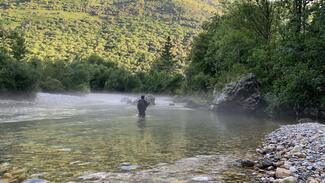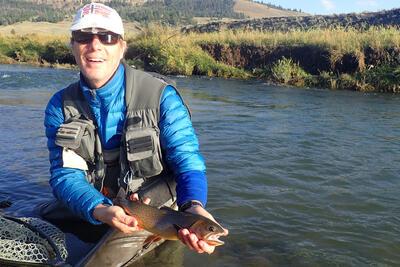
In my search for new nearby horizons, Asturias had been at the top of my list for some time. As in other Spanish provinces, get the permits was a real barrier and I needed a contact on site to be able to properly organize a fishing trip.
I was not thrilled that the 2022 World Fly Fishing Championships were being held in this Spanish province, thus drawing attention to a territory that I hoped would be uncrowded. However, this would allow me to finally have my contact there. Indeed, to prepare for the competition on Iberian land, the French team were serviced by a local guide; Calos Bobela. He was unanimously appreciated by our competitors for his competence and kindness. Contact with Trout & Co would be made during the interview with Julien Daguillanes, crowned during this competition individual world champion for the second time.
I contacted Carlos earlier this year to target the most favourable time. I don't speak Spanish, but he speaks English well enough to be able to talk about fishing. He then offers me two options: Early April to track down big fish with dry-flies in the downstream sectors of certain rivers or June, when all fishing sectors are open, and the water is at the right level most of the time. I accepted both options to have an overall idea of fishing in this region, it only takes 5 hours by car to get to Asturias from Gironde.

1ST PART: APRIL
For my first trip, we would spend 3 days together at the beginning of April and we would meet on the banks of the Rio Caudal. I admit to having been surprised by the surrounding when I arrived the day before. I had images in my mind of rugged coastlines with nearby mountains and lush green nature. While this was what I could see from Santander, when I arrived at my destination I found an industrial landscape, mines, factories, and social housing type house. Many installations are abandoned: mines, considered unprofitable and polluting, had started to close 30 years ago.
The river is bordered by a road, a highway, and a railway line. The route is completely recalibrated with a succession of small roads. All this is not very bucolic.
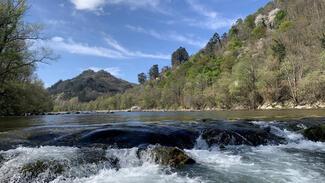
But once your feet are in the river, you partly forget this surrounding. The water is very clear, and the pebble bed is very pleasant for wading.
Despite the bright sun, Carlos hopes for a hatching at early afternoon. He makes me catch a few fish on nymphs under the water jumps and then makes me fish with dry fly to know what I am capable of. He explains to me that the fish here are very tough and that it is better to catch it on the first try. Fine tipped and a ultra precise cast without dragging to have a chance.
I arrived with a series of March Brown and Baetis Rhodani assembled for the stay but Carlos wants me to use his emergent ones in cul de canard. You must cast far and direct, with a fine tipped (10/100) and see your fly. The CDC are doing their job.
Around 2 p.m., the Baetis hatch begins, and we quickly observe some bites. In a return, I bring up a first big fish which break out me when hooking. I haven't fished trouts since last September and have just had a big fishing season of p predators with streamers. We're going to have to put a little sweetness back on the menu. A second fish is active on the same position and this time I just tighten the line when it takes my fly. Although smaller than the previous one, it is a superb fish of over 50cm which ends up in the landing-net. My first big trout from Asturias.
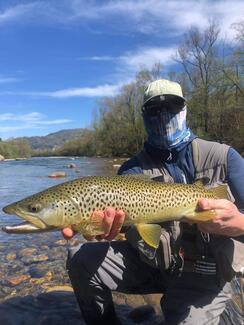
The trout here are sublime. Of Atlantic stock with only black spots. The mouth of a sea trout, except for the skin colour.
Carlos has just sighted a beautiful trout gobbling on the right bank, under the foliage. A strong wind is coming up the river and I am unable to achieve, on the other side, the curved pose required to attack this fish. I end up handing the rod to my guide, who, with equipment he doesn't know, achieves the perfect pose on the first attempt. I feel rubbish!!!
Through hard work, I managed to catch some magnificent trouts, while the Baetis were still on the water. I take another over 50cm and a fish that Carlos estimates to be around 60cm break out of me and which passed in front of us several times during the fight.
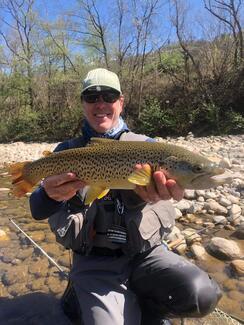
No March Brown with this bright sun, but the hatching of Rhodani lasted about 2 hours, allowing me to attack a dozen big fish in dry flies.

We extend a little the nymph session in the streams and around 5 p.m. we feel that it is over for today. This is early season fishing.
The next day, Carlos suggested that we move around to the province of León. He got for me both permits so that we could choose a most suitable sector at the last moment, depending on the conditions. We cross the Pajares pass to reach the río Bernesga. It is a fairly modest watercourse, typical of the mountains.

We are at much higher altitude, tres still do not have foliage and water is very cold. We fish with nimph. The catches are numerous but the fish are much smaller size than the day before and they do not have the same colour as the «beauties of Asturias».
Carlos tell me that we can continue on this zone for the rest of the day, but that with the cold water we should not expect to dry-fly fish. Being the objective of this first trip locating big trout, we come back to río Aller, tributary of río Caudal, at the time of hatching.
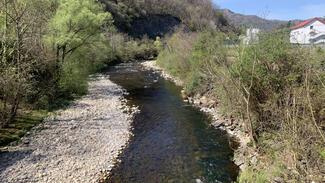
The first bites happen quickly, but they are only quite small fish. Arriving at the end of a large apron, I see a beautiful fish feeding in the shades of the trees. Following the advice of my guide, I tied one of its CDC flies to my long 10/100.

Yesterday’s session brought me up to the pace a little and I set my fly with precision on the first cast. The trout bite and I immediately realize that it is much bigger than I imagined. I have to handle gently with fine tipped while trying to prevent the fish from going further deep into the current. Carlos films the scene while the trout rewards us with a magnificent leap.

My guide estimates it to be around 60 cm. After a few up and down turns in the apron, the trout heads for downstream current and my leader breaks when I try to prevent it from sliding down.
I'm a little disappointed but spot another fish rising. I decide to switch to 12/100 to avoid another breakage and this time, the trout ends up in the landing net. Another magnificent 50+. The hatching is already over, the weather is not favourable. Like the day before, we stop fishing quite early.
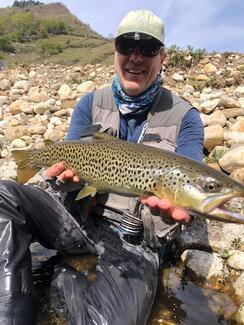
For our third and last day together, we return to the río Caudal, but my guide checked this morning that several anglers had taken the same preserve as us, so we follow the river to find an area without competition. Today, Carlos is in fishing and photo mode, not guiding.
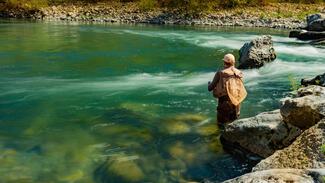
When I observe him, I am impressed by his technique. The day is not very favourable, because the weather is still nice, but even hotter and the wind is blowing strong.
Despite the very low activity, Carlos ends up spotting a fish rising in the river side.
The trout bites quickly and then begin a fairly long fight. It looks really big. Carlos has gradually moved away from the rock blocks and can take time to work away from obstacles. It’s an incredible fish that will end up in his net. We don't measure it, but it's well over 60 cm, with the characteristic colour of the fish here. And in 11/100.
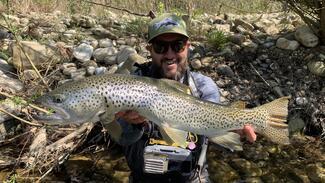
There are two other active fish in the same area and Carlos will let me catch them. They are not as impressive as his catch but, in any case, exceed the 50 mark.
It’s the end of this little spring break and I’m back. I have very mixed feelings about this first experience in Asturias. As announced by Carlos, we caught some big trout on dry flies. Fishing is extremely technical. The guide, very influenced by the competition, is of a very high level. For him, every detail counts, and he pushed me to leave the comfort of my habits for more efficiency (even if I didn't always agree on the choice of line diameters, which made us laugh). This is all positive, but I really struggled with the surroundings of the rivers we visited. However, after only a few kilometres, I find these typical landscapes of the region, where sea and mountains mix in a green setting. So, I will have to come back and discover something else.

PART 2: JUNE
For this second trip to Asturias, I am accompanied by my friend Jean-Louis. His campervan will allow us to adapt better to the bad conditions of the moment. The flows are very low, and storms break out almost daily, making certain rivers unfishable for a few days. Impossible to make a program, you must improvise. We have planned a week of prospecting including 2 days with Carlos. He will guide us remotely the rest of the time.

Our first casts will be on the Rio Cares north of the “Parque Nacional de los Picos de Europa”. The river, with its translucent waters, is a true marvel. The fishing is difficult, consistent with the reputation of the province. We catch a few fish with nymphs then dry-fly fishing. I am delighted to find the typical colour of these trout.
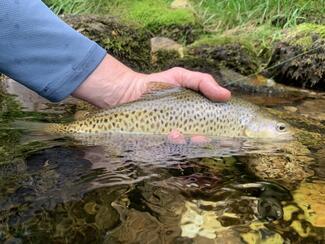
The catches are less than in spring but the pleasure of fish such a beautiful river is immense. During the evening moves, two large trout (perhaps sea trout) place themselves in front of a submerged rock, but I was unable to get them to move with a visual nymph despite numerous changes of flies.

I had clarified to Carlos that for my second visit that for the choice of rivers I wanted to focus on the setting. It is, therefore, a perfectly successful introduction, the magnificent waters of the río Cares flowing into a spectacular valley.
The next day, we head west to join our guide, who is waiting for us on the banks of the Rio Piloña.
The introductions between Carlos and Jean-Louis are made easier because my friend, unlike me, speaks Spanish fluently.
The water level is very low, like everywhere at that moment, but the Río Piloña remains being a pretty little lowland river. It’s Jean-Louis’ turn to take advantage from our guide’s technical advice.
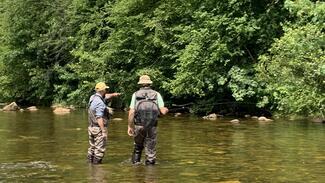

The weather conditions and the water height make fishing difficult, but we regularly catch a fish. The technical expertise of our guide is as valuable as ever and my friend, who has not been fly fishing for a long time, is very eager for information.
For our second guided day, Carlos planned to accompany us on the Rio Trubia.
On the downstream part, the water is really cloudy with the night storms, but going up its course, we quickly found it clear enough for our activity.

It’s a different scenario from the day before. The river has a more mountainous profile and flows through a gorgeous forest. The water clears quickly, and the fishing is immediately very fruitful. Carlos goes from one angler to another to push us even further in mastering our drifts with small nymphs and fine tipped. I must admit that his advice is really useful, and I didn't think I could make so much progress in such a short time on a technique that I have been practicing for quite a few years.
The beginning of the afternoon will offer us a nice hatching and fun dry fishing. Some pretty fish, always with the same dress, will be caught during this session.
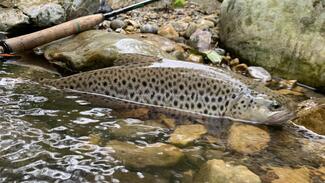
In three days, we saw rivers with different profiles. All very pleasant and perfectly suited to my request. We didn’t put up with any fishing pressure. The surrounding nature is beautiful, and the villages are typical, including numerous horreos (wooden and stone granaries raised on pillars ending in flat supports to prevent access to rodents).
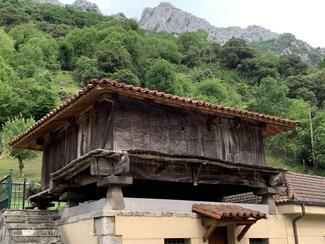
We now want to go and discover the rivers near León. Carlos knows the region perfectly and will guide us remotely.
The campervan proves to be a valuable ally because the stormy weather often forces us to change our plans, sometimes at the very last moment.
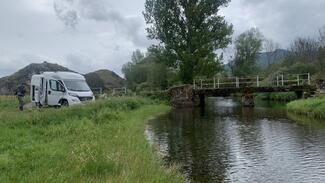
After a quick and unsuccessful evening trip on the Rio Cubia, where the waters are really too low, we arrive in the Rio Luna valley. The downstream route is magnificent, but steep. We contact Carlos to try to get the preserve, but requests are made in January, and they are sold out for all season in one day. We therefore fish a little further upstream, where the river has a chalk stream profile. We caught a few fish on dry, but we quickly noticed that the level was too low for the fishing to be really good.
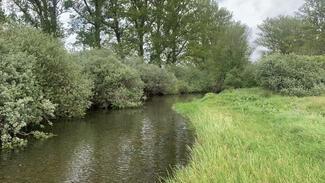
We continue the day on a tributary, the Río de Torrestío. The gradient is stronger, and the lack of water is felt much less. A mayfly hatch is underway, and the fishing is immediately excellent. The weather, favourable today, extends the period of activity and we catch many fish, exclusively on dry for me.
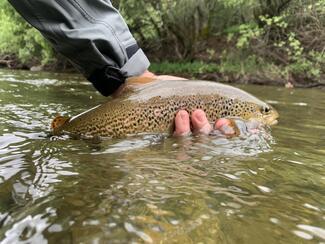

We continue exploring the rivers of León via the Rio Sil. The name of this river may not be unknown to you even if you have never been to the region. It is in fact a wet fly well known to fly tyers.

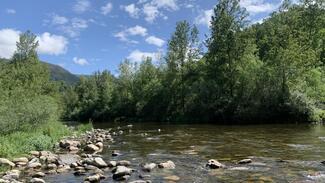
Still guided at a distance by Carlos, we attack a magnificent free section. Nymph fishing is not productive but dry fishing brings up fish even outside of hatching periods. Small imitations of mayflies or sedges bring us many fish throughout this session. An almost perfect day where you can only regret not having caught a few bigger fish. Our guide explains to us during the daily briefing that the route is nevertheless renowned for its large specimens and that we did not touch them due to the very low water level.
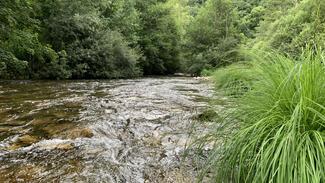
To continue our quick getaway to León, and after having quickly tested a downstream sector of the Rio Luna, we leap to explore the Rio Torio. The site is magnificent, the river sometimes flowing in spectacular gorges, but a recent storm has strongly tinted the water and we must be content with the views.
On the way back and after cross again to Asturias, we do one last session on the Rio Cares, whose clear waters had left an impression on us.
This week in June allowed us to discover rivers that were very different from those visited in April. Often marvellous, they are home to beautiful populations of trout. Most of the sites are magnificent and the fishing pressure seemed very low to us (2 fishermen seen in one week). It took a technical approach to achieve some results and the presence of Carlos (at our side or remotely) was a major advantage. Being able to fish mainly on dry fly will have been one of the satisfactions of this week.

To conclude with my discovery in 2 stages of Asturias (and a little of León).
What struck me the most was the difficulty in catching the big fish in this region. You need a very technical and mastered approach and make no mistakes.
Carlos is a guide with an exceptional level of fishing, and I am not surprised that he even impressed the members of our French team.
My two stays corresponded perfectly to what my guide had announced:
- April: Large fish fishing with dry fly during the short periods of activity in the early afternoon. The sessions take place on downstream courses whose environment I did not appreciate.
- June: Lots of options, especially on small and medium-sized rivers, often in magnificent surroundings.
I recommend the destination to experienced fishermen wanting to tackle difficult trout or (and) to those wanting to discover new quality fishing destinations, far from busy routes like the rivers of Catalonia.
Accompaniment by a guide like Carlos is essential for me.
